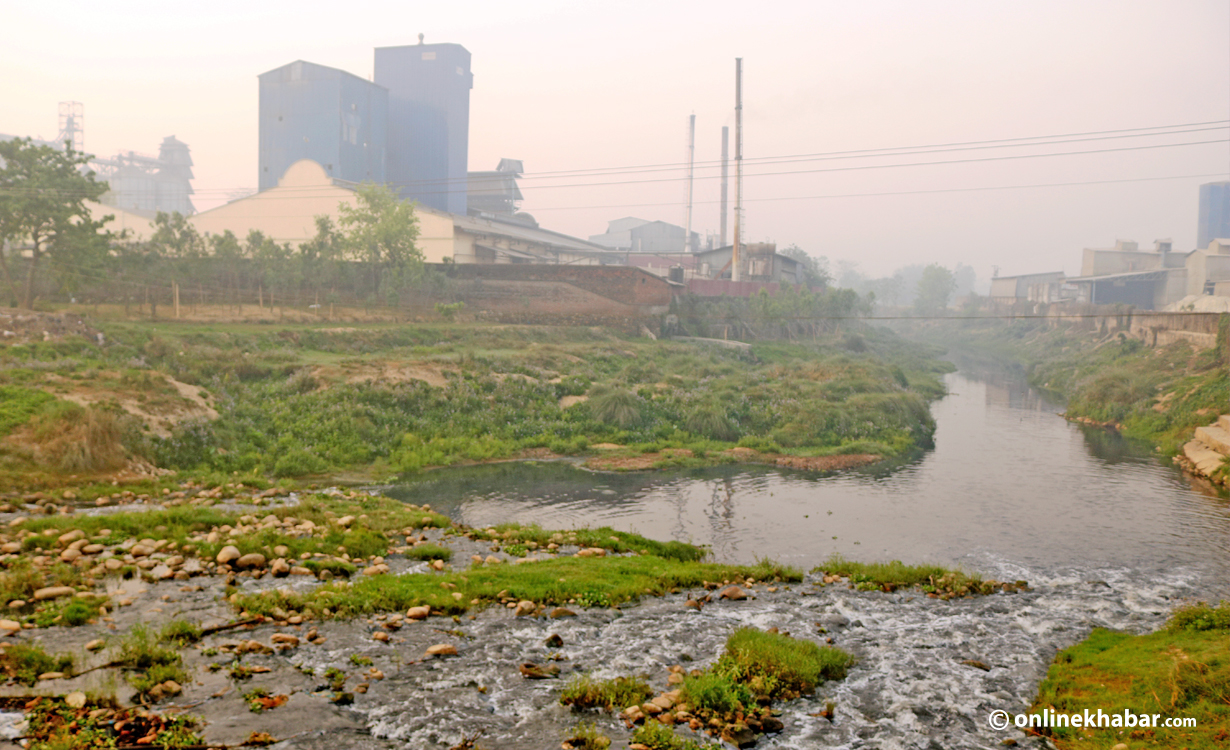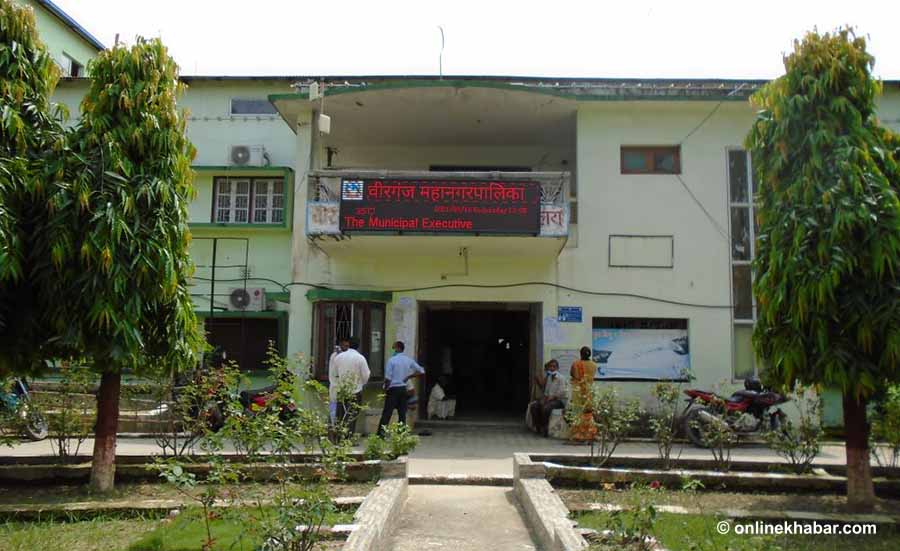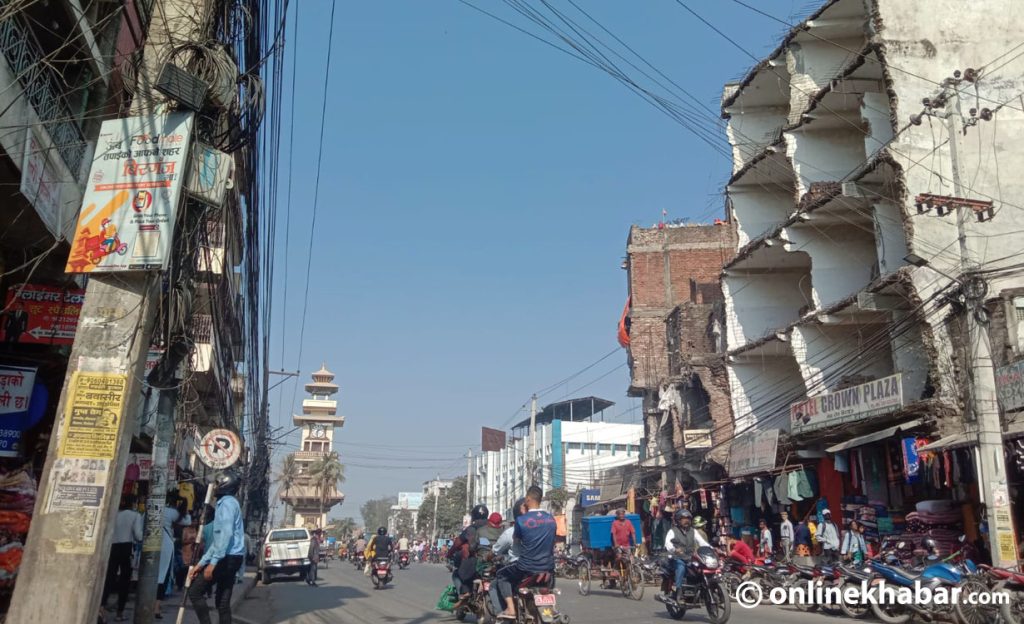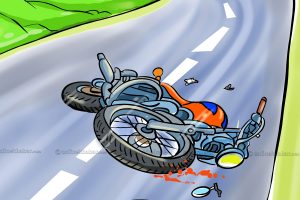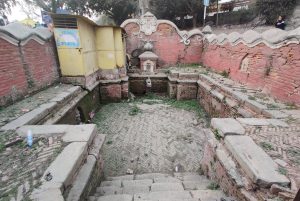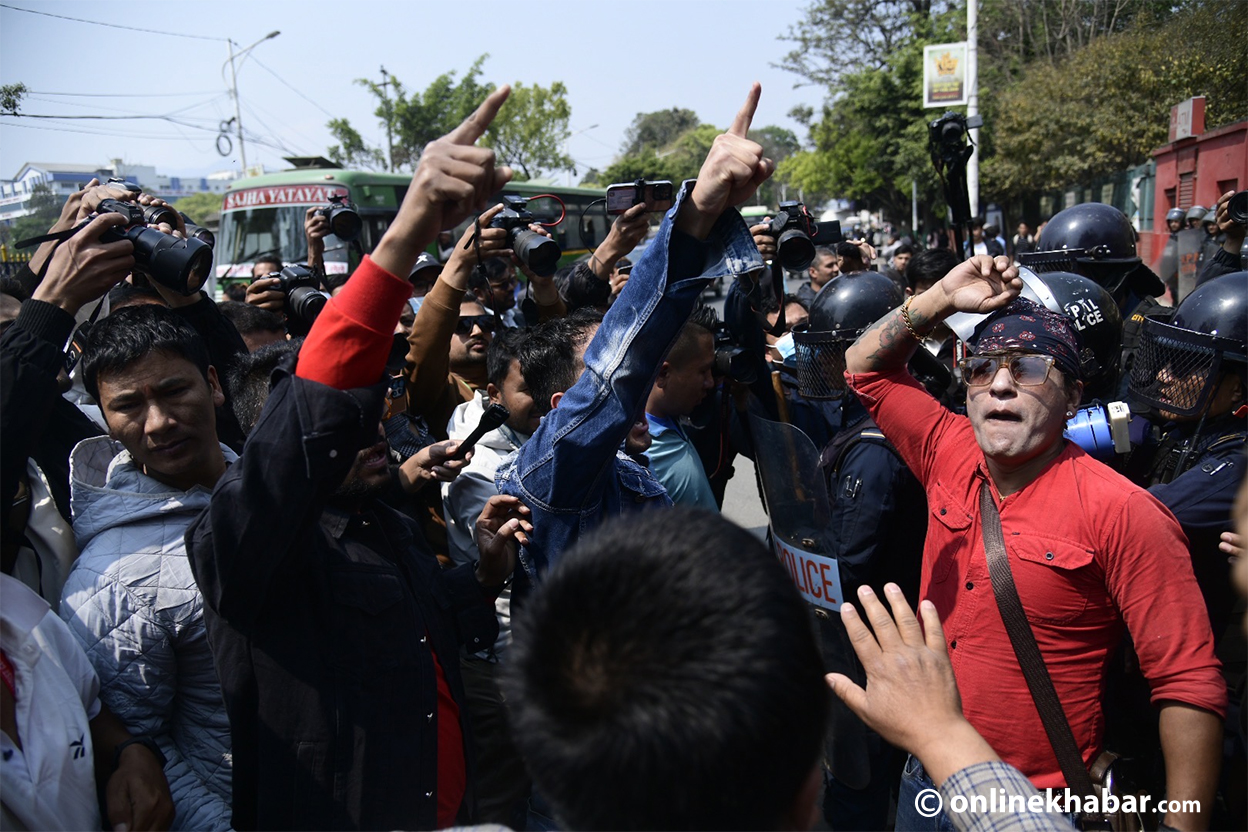When Naresh Mahato in Tajpur of Bara says he used to drink water from the Sirsia river, many people do not believe. It is not hard to see why. Ever since they have seen it, tar-black, stinking water has been flowing in the Sirsia. The water is so dirty that it is not drinkable, even for cattle. People get blisters if they bath in the river.
A few kilometres upstream, the water is clean. The locals drink and use it for household purposes. It is a far cry from the river a few kilometres downstream because of the negligence of the industries and factories that drain wastewater into the river. Despite the years-long river pollution and campaign against it, the regulatory bodies have shown no interest in enforcing laws. Nor do the polluting industries consider it their responsibility.
The chronicle of carelessness
The Sirsia river, which originates in a bush at a forest called Ramban in Jitpur Simara sub-metropolitan city of Bara, flows all year round. Two of its tributaries–Kiyasut and Vaudyi–merge into it before it reaches Birgunj. The river, however, is plagued by industrial pollution before it reaches Birgunj.
The river pollution grew after factories and industries were set up in towns including Simara, Jitpur, Nitanpur, Chhatapipara, Parwanipur and Birgunj. The first industry dates back to at least the 1940s. But it has been only a few decades since industrial effluents have turned the river into a tar-black sludge.
Over the last four decades, the number of industries in Birgunj’s Pathlaiya area has multiplied. The area is home to around 2,000 small, medium and large enterprises and factories. No one has paid attention to the proper management of solid or liquid waste that is released into the river. Some openly discharge wastewater into the Sirsia river while others do it discretely.
The river pollution has had a direct impact on the people living in Simara, Bakulia, Lohsanda, Ramauli, Sagardina, Rampur Tokani, Chhatapipara, Nitanpur, Gambhargaon, Behra, Baluwa, Sirsia, Tajpur, Bhaluhi, Ramgadhawa, Parwanipur and Birgunj metropolitan city. The pollution has killed the river’s aquatic life. “Fish, frogs and snakes have vanished from the river and the banks,” says Amzad Miya of Bhawanipur.
Dr Atulesh Chaurasia, a dermatologist at Narayani Hospital, says people who use the river’s water are at risk of cancer. People living near the river are suffering from skin infections, asthma and cough caused by the pollution, he says.
Lakhan Lal Sah, the chairman of the Sabaiya Forest Users Group, recalls drinking water from the Sirsia when he was young. “People believed the water was mixed with herbs and it cured stomach ailments and wounds,” he says. “But now, we get sick if we use it.”
Local farmers are forced to irrigate their vegetable farms with polluted water from the river. The animals get blisters if they bath in the river. The river has also been encroached upon.
The river pollution has affected the people of Raxaul in neighbouring India as well. They have launched a campaign called Save Sarisawa River. Dr Anil Sinha, the coordinator of the campaign, says, “River pollution has affected many people in the area. We have put pressure (on the local authorities) to control the river pollution, but we have not succeeded.”
A river of garbage

Untreated sewage and chemicals from factories and industries of leather, steel, cement, distillery, textile, ghee, and soap along Birgunj-Pathlaiya Industrial Corridor have been drained into the river. The tanneries discharge waste including debris and dead animals into the river.
The burning of husk to run the boiler and the black ash that is extracted from sodium silicate from the iron factory also flows into the river. Locals throw both decaying and non-decaying materials into the river. The municipal sewage drainage flows into the river. Before the metropolitan city office established the garbage processing centre, it too disposed of the garbage collected from various wards along the banks of the Sirsiya river.
The untreated wastewater from the Annapurna Vegetable Products in Parwanipur is released into the drain of Birgunj-Pathlaiya road. On the one hand, it emits a fetid smell, it reduces the fertility of the soil, on the other. The pollution has affected about a one-kilometre area including DAV Kedia School. “We are facing a problem because industrial wastewater has been dumped on the road,” says Sanjay Mishra, the engineer of the Birgunj-Pathlaiya road project.
A few years ago, a tannery near the temple on the banks of the Sirsia river in Jagarnathpur relocated after locals protested against it. “The fetid smell spread all over the village. So, we demanded the factory be relocated. They resisted. But, they were forced to relocate after women too joined the protest,” says Lal Mohammad Miya, a local.
Nine years ago, Binod Prasad Shah and Bhojraj Pant from the Himalayan Alliance for Climate Change and the Nepal Academy of Science and Technology, conducted a study on the water quality of the Sirsia river. They studied the river’s ph-level, temperature, chemical oxygen demand and biological oxygen demand. The study found more than 250 industries discharged wastewater into the river.
Another study by the Ministry of Population and Environment in 2016 reached a similar conclusion. Over 250 factories and industries around the industrial corridor release untreated wastewater in the Sirsia. But, even after two major studies pointing out the source of pollution, authorities have failed to control it.
According to the World Health Organization, if more than 500 milligrams of solid material is found in a litre of water, it is defined as polluted. A 1984 study by chemist Uttam Kunwar found 1.1 grams of solid material in the waters of the Sirsia river. Dozens of enterprises have opened since then. But, no study has been conducted on the amount of solid material in the river.
Pollution from the tanneries

Nepal hosts 14 tanneries including 10 along the Bara-Parsa Industrial Corridor. While these factories may have significantly contributed to the national economy, they are also responsible for polluting the Sirsia river.
Leather processing expert Hari Gautam claims the tanneries account for 50 per cent of the pollution in the Sirsia river. According to him, tanneries use salt to protect the skin from decay. It keeps the skin dry. They wash the skin with soap and water. Lime is also used to inflate the skin. The tanneries add sulfuric acid to remove hair and blackheads on the skin. “The chemicals that are used to clean the skin are harmful to our health,” says Gautam.
Narayani Leather and Manufacturing has opened two plants in the area. Similarly, Everest Leather Industries is located in Rampur Tokni and Standard Leather Industries and Progressive Leather Industries in Parwanipur. Others in operation include Mariyam Leather Industries in Jagarnathpur, Nepal Tanning Industries, National Leather Industries in Bahuari, Global Leather Industries and National Leather Industries Pvt Ltd in Lipnibirta. Most tanneries lack a water treatment plant. That is why they release the chemical waste directly into the river.
In 1997, with the support of the United Nations Industrial Development Organization (UNIDO), Everest Leather built a central effluent treatment plant on a three-acre land to treat the wastewater. Narayani Leather operated a separate effluent treatment plant. Currently, the treatment plants appear dilapidated and unused. According to Gautam, a leather processing expert, the factories do not install the plants because of their high operation cost.
The chemical wastewater released from the tanneries can be treated to some extent by using”pit technology”, according to Gautam. According to this technology, once a pit fills up, it drains into another. The water from the last pit is released into the river. But the tanneries have not adopted this technology.
Prabhu Prasad Chaurasiya of Jagarnathpur says the draining of the wastewater from tanneries directly into Sirsia River has caused the problem. “Our house is by the river. So, it always stinks. Oftentimes, dogs rummage through the filth looking for bones. They also attack our livestock. We are in trouble,” he says. “They could have collected the wastewater from the industry on a pond and release it when it rains. But, they don’t even do that.”
Sanjay Giri, the president of the Nepal Leather Trainers’ Association, says the allegation that the leather industry caused pollution is false. The leather industries’ effluent treatment plants have broken down and are only partially operational, according to him. He claims his leather factory called Everest Leather Industry releases water into the river after treating it using pit technology. “Because the water is blackened, everyone blames the tanneries, but other industries such as cement, paint, steel also pollute the river,” he says.
Binod Kumar Chaudhary, a leather processing expert who has been overseeing the industries’ management since 1991, says the pollution was apparent due to the use of chemicals and smells of raw leather while processing. “Other industries also use hydrochloric, sulfuric acid and pour wastewater directly into the river. But, because of the stench, the pollution from tanneries cannot be hidden,” he says.
Vanishing culture

Until clear water flowed in the Sirsia, locals celebrated a festival called Kattik Nahan, in which pilgrims bathed in the river during the month of Kattik (mid-October to mid-November). Young people growing up around the river do not know what Kattik Nahan is. “The river is bereft of water. Debris flows through it. The river stinks. No one wants to go in. How can I take a bath?” says Nanda Devi, a 52-year-old resident of Inarwa in Birgunj.
Dozens of makeshift shrines are built on the banks of the river during the Chhath festival that honours the sun god. But, devotees cannot immerse themselves in the river and worship the sun god because the water is too filthy to do so.
Every year, the members of the festival management committee make a request to the police to issue orders for the factories to clean the river for the occasion. After an outcry, the industries shut themselves for a few days so clean water flows in the river. The locals celebrate the festival on the riverbank. A few days later, the river gets polluted again.
Things were a bit different in 2020 as due to the Covid-19 pandemic, all factories remained shut during most parts of the year. That meant the Sirisa river got to breathe a little as no waste was released into it. But, there have been examples of factory operators misbehaving with authorities during the festival.
During the last Chhath festival, authorities had to force the factories to clean the river. Himalayan Pet Products Pvt Ltd used to release chemical water directly into the Sirsia. In October 2019, when a police team arrived at the plant, Chinese owner Liuta Chuang, 36, and Indian manager, Tinjung Gurung, 35, misbehaved with the police. The police arrested the two and charged them for public order offence.
On November 4, 2019, then chief district officer Narayan Prasad Bhattarai convicted the two with a fine of Rs 8,000 each. In the wake of the ruling, factories stopped releasing the wastewater into the river. But, a few days after the festival, pollutants were poured into the river.
According to a local tradition, people considered the river’s water as holy water and used it in cooking dal (lentil soup) at weddings. “The river is so polluted that people have given up the practice,” says Lakhan Lal Sah.
Dead bodies are cremated along the Sirsia river. Earlier, after the cremation, people would take a bath in the river, but they no longer do so now.
Lack of regulatory scrutiny

According to the Local Government Operation Act 2017, the local government should regulate and monitor waste management and river protection. But, the Birgunj metropolitan city itself dumps the city’s garbage on the banks of the Sirsia river. On average, the metropolis collects 50 metric tons of garbage every day, according to the city office’s sanitation division chief Rajib Singh. It is dumped on the stretch of the river from Ramraj bridge to Miteri bridge. The sewage from neighbourhoods of Padam Road, Ranighat, Adarshanagar, Chhapkaiya is drained in Sirsia. This stopped after the local government bought 26-acre land for Rs 476 million.
With Birgunj metropolitan city least interested in managing waste, the Sirsia river and even small streams around the city and the city itself has become polluted. The city office, even today, releases the sewage system from Padam Road, Ranighat, Adarshanagar and Chapkaiya into the Srisia river.
Under the Medium-Sized Cities Integrated Urban Development Project, a water treatment plant has been constructed in Chhapkaiya. The plan is to treat water from the houses and toilets covered by the project before releasing it into the Sirsia river.
Singh says they are forced to dump solid and liquid waste in the river as the waste processing plant is under construction and the treatment plant has yet to come into operation. “We dump the garbage in the river because we don’t have any alternative,” he says. “The problem will resolve once the processing plant and treatment plant comes into operation.”
The Asian Development Bank-funded treatment plant, which completed four months ago, has yet to function due to insufficient water. Singh says work was underway to supply enough water to the plant.
Binod Gupta, an environmentalist and one of the researchers on pollution of Sirsia river, says the metropolitan city should collaborate with industries to collect the wastewater in pipes, treat the industrial waste and drain it to the river. “And, they should charge the industries for this.”
Letting polluters off the hook

In October 2020, the Environment Ministry took action against 26 polluting enterprises. But, the ones that pollute the Sirsia river were not among them.
In 2010, the Sirsia River Monitoring Committee was formed in Birgunj. In a report, the committee said Birgunj sub-metropolitan city’s illegal distilleries and the industrial area’s 46 large and small industries had polluted the Sirsia river. The committee also made recommendations to control pollution. It had even identified industries to be punished. “We submitted the report to the district administration office of Parsa. But, it never implemented it,” says Ritesh Tripathi, the committee’s coordinator.
On November 6, 2019, the Birgunj Chamber of Commerce and Industry held a meeting of stakeholders on the pollution of the Sirsia river. Narayan Prasad Bhattarai, who was the chief district officer at the time and Vijay Kumar Sarawagi, the city’s mayor, attended the meeting. The discussants urged the factory owners to properly manage all types of pollution– liquid, solid and air—that they emit. During the discussion, Mayor Sarawagi said, “We cannot play with the lives of thousands of people under the pretext of providing employment. It is ok to shut the industry down. But, river pollution is a crime.” Sarawagi is a former president of the Birgunj Chamber of Commerce and Industry and a former member of the Federation of Nepalese Chambers of Commerce and Industry.
Bhattarai said the metropolis and the district administration office were cooperating to keep the rivers and ponds clean. “Garbage can no longer be dumped in rivers and lakes. We will take action against those who do that,” he had said at the time. But, there is no follow-up. Neither the industrialists nor the businesspersons took the matters raised in the meeting seriously. Both the city and the district administrations failed to monitor or take action.
Mayor Sarawagi says that there is now a need for authorities to visit these factories and households personally and punish the people involved in polluting the river. “The river is polluted by both factories and household. We’ve been requesting them no to so for a long time. But now, we need to be strict and take action against anyone who violates our orders. It won’t look nice, but we have to do it,” says Sarawagi.
Gopal Kedia, the immediate past president of the Birgunj Chamber of Commerce and Industry, says he has written letters to all industries as per his commitment. “Not all the industrialists have members in the union. We have written to them instructing our affiliates to stop the pollution,” he says.
But, hardly anyone wrote back to the Birgunj Chamber of Commerce and Industries, which is why Kedia says that everyone needs to be on the same page if they want to clean the river. “One body or one organisation cannot do anything,” he says.
On March 13, 2021, a talk was held with activists and industrialists under the leadership of the newly appointed CDO, Asman Tamang. But, this talk could not bring about any solution to clean the river. CDO Tamang, hopeless, tells Onlinekhabar that he has no right to take action against the factories.
“The major pollutants are the leather factories and few other factories who release the wastewater directly,” he says. “We have been requesting them, but they are still doing it. We want to take action, but the laws don’t help us.”
The Department of Industry is also responsible for approving the preliminary environmental assessment reports. The director-general of the Department of Industry, Jiblal Bhusal, says the department will take action against the factories if they receive a complaint from local governments or the public regarding the factories not following the standards for environmental pollution control.
“We’ve been requesting factories for a long time. But we just don’t have the human resources to go visit these factories individually,” says Bhusal. “If we receive a complaint, we will send a team on the day and take action against them.”
Advocate Nawal Kishor Yadav says there is a tendency to make promises now and then and not implement them. “Locals raise issues and agitate. Then, people pledge to control pollution. But, it will not be implemented,” he says.
Om Prakash Sah, the chairman of the Clean Environment Campaign Nepal, expresses sadness over apathy towards the study reports. “Even if the report clearly reveals which industries cause pollution, no action will be taken. What could be more embarrassing than this?” he says.
The Sirsia river flows down to India through Jitpur-Simra sub-metropolitan city and Birgunj metropolitan city. Local officials of both metropolia are unanimous on the issue of controlling pollution. But, they do not seem to have the gumption to take action against the industries polluting the river.
According to the Local Government Operation Act 2017, the local governments should formulate policies, laws, criteria and plans related to environment protection and biodiversity and implement, monitor and regulate them. They should run programmes on environmental risk reduction. The Birgunj Metropolitan City has introduced the Waste Management Act that says chemical and industrial waste should not be dumped without treatment. It requires the industries to manage and process the waste they produce. Not following it will result in a fine of Rs 50,000 to Rs 100,000.
The executive meeting of the city government, on November 15, 2019, had authorised the ward chairpersons to recommend action against the industries that pollute the rivers. After the recommendation, the city will request the district administration office to take action.
But, so far, no ward chairperson has recommended it. The mayor or deputy mayor and district administration officials have yet to nudge them towards doing it. Some have even criticised the mayor for shifting the responsibilities to the wards.
Chumandas Chaudhary, the ard chairman of Birgunj’s ward no. 31, says a letter has been sent to the industries directing them to stop pollution. “Our ward is home to industries that make paper, plywood and cartoon. If they don’t stop pollution, we recommend authorities to take action,” he says.
What’s in the law?
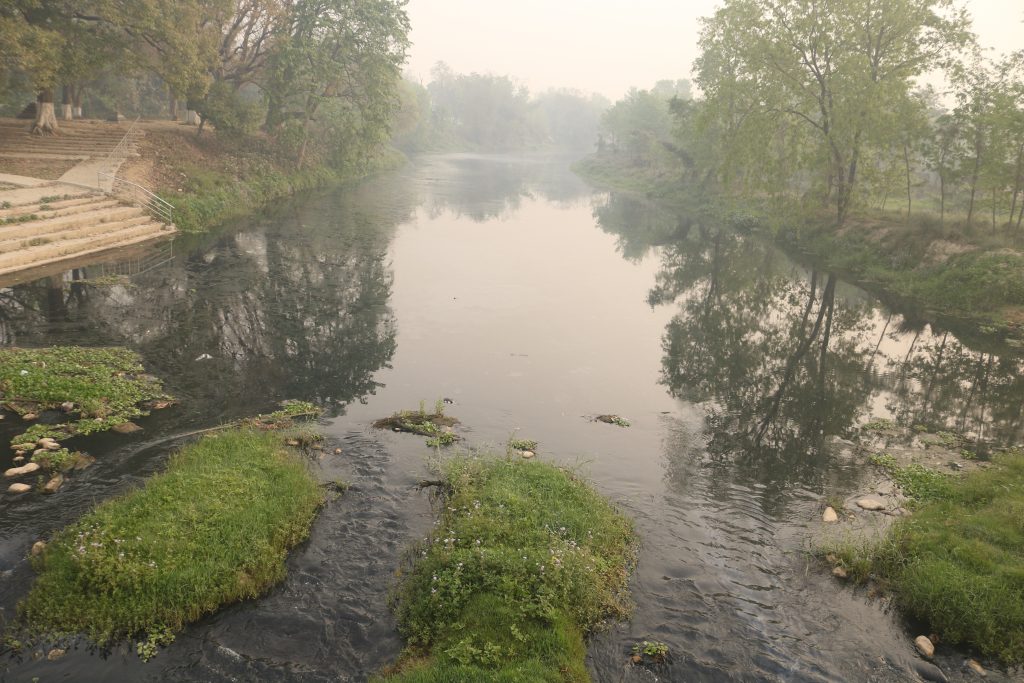
The Environmental Protection Act requires an environmental impact assessment before setting up a factory. The application for the factory is approved only after ensuring that the environment will not be affected or its impact can be controlled using various methods and processes. The law also has a provision for compensation in case of loss to anyone due to the industry. The Act prohibits the emission of pollution that could have an adverse effect on the environment or endanger public life and public health or emission of sound, heat, radioactive radiation and other forms of pollution from industries.
Section 111 of the Criminal Code 2017 states water should not be polluted. A person who pollutes drinking water or a water source is liable to imprisonment for three years or a fine of up to Rs 30,000 or both and a person who contaminates or causes water to be used for other purposes is liable to imprisonment for six months or a fine of up to Rs 5,000 or both.
Section 112 stipulates anyone who produces, processes, transmits, disposes, emits, dumps garbage in a way that has a significant adverse effect on the environment is liable to imprisonment for up to one year or a fine of up to Rs 10,000 or both.
In the Bara-Parsa corridor, most industries opened even before the enactment of environmental laws. There has not been any initiative to make these industries comply with the law. Advocate Kamal Mohan Pokharel says due to the indifference of industries as well as the law enforcement agencies, the public has to suffer from environmental degradation.
Ignoring people’s voices
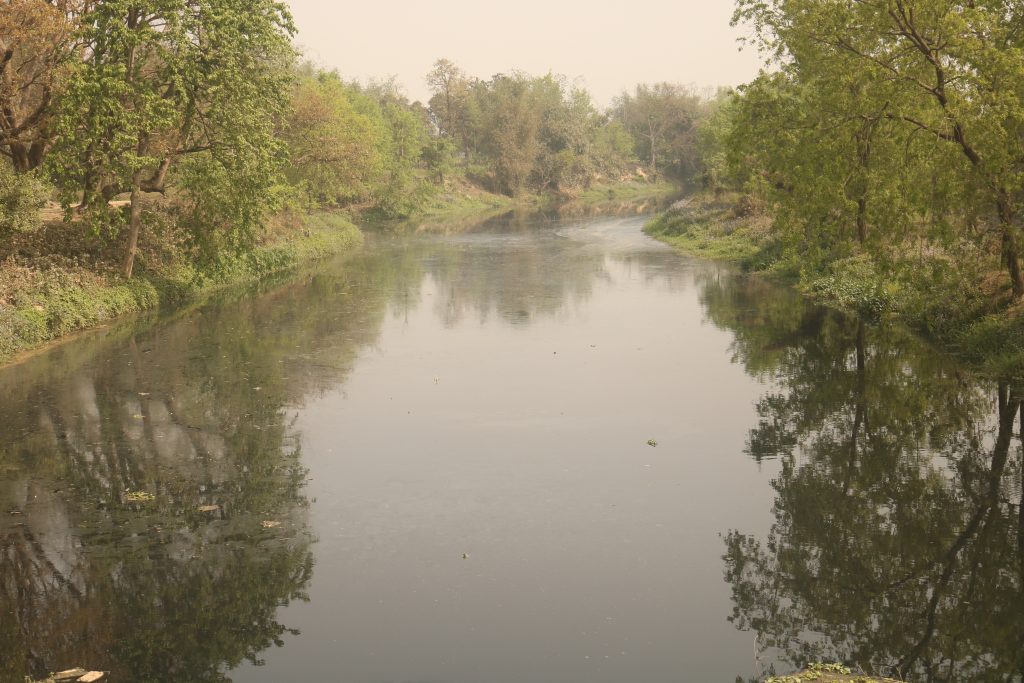
Led by Gokhul Kurmi, in 1991, local people agitated against the pollution from Birgunj Sugar Factory, Sreepur-based tanneries and textile mills. At the time, they also demolished a canal of an industry that polluted the river. Now, Gokhul’s son Advocate Surendra Prasad Kurmi leads a campaign against pollution with the slogan “Healthy Life, Prosperous Birgunj.” As part of their campaign, they have handed the river’s polluted water to the district administration office and Birgunj metropolitan city office. They have also collected signatures.
On October 26, 2019, Kurmi, the campaign’s coordinator, filed a case in the Parsa District Court against the city, Sushil Vegetable Ghee Industry, Standard, Mariyam Leather Industries, Global Leather Industries and Nimbus Pvt Ltd. The case is pending in court as the two of them did not accept the summons. Five others have replied to the court saying they now release the wastewater after treatment. But, Kurmi is far from satisfied. “If they did it, how come the river is still polluted?” he says.
He says that due to the local bodies lack of fortitude, the river continues to be polluted. “We have led multiple campaigns which have resulted in nothing. Now, we are knocking on the court’s doors,” he says.
Kurmi challenged the city government and 46 factories and enterprises in the Janakpur High Court seeking a restraining order. On September 25, 2019, the high court sought a reply from the defendants in the case. He says the campaign will continue until the Sirsia river is clean. “We will stop our campaign if the industries stopped dumping wastewater in the river and manage it,” he says.
Lakhan Lal Sah, the chairman of the Forest Users Group, says even though he had been raising his voice for years to save the river, no one paid attention to it. “We are not saying the industries should not operate here. We are saying they should not dump untreated wastewater in the river,” he said.
Jamuna Prasad Yadav, the former chairperson of Prasuni Birta VDC, says despite raining the voices, authorities ignored the plight of the people of affected areas. “I have been raising my voice since I was 24 years old. I’m 64 now. Nothing has changed so far,” he says.
Jaspal Singh, the chairman of Prakriti Sewa Pratisthan, Nepal, says political parties should be responsible to control river pollution. Nanda Lal Shah, a resident of Bhawanipur in Birgunj echoes him. “Until the industrial pollution is a part of a political agenda, we won’t see clean water flowing through Sirsia River,” he says.
(This story was reported under Investigative Multimedia Fellowship by the Media Foundation in collaboration with Humanity United.)



